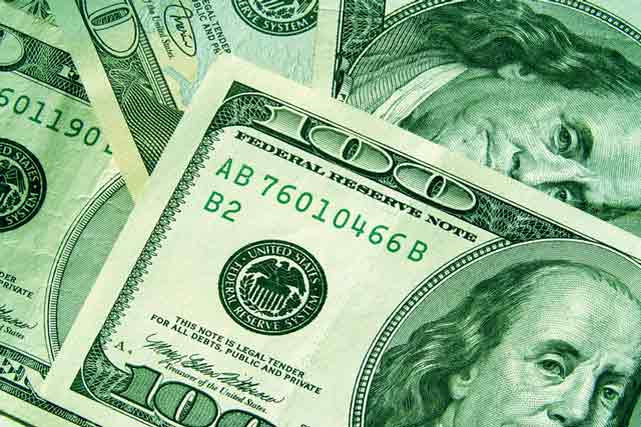Pound to Dollar Rate Forecast: 1.32 Hold as "GBP Most to Lose"
- Written by
Ben Hughes

Currency exchange strategists at SocGen forecast the GBP/USD exchange rate will strengthen to 1.38 by the first quarter of 2026 as the dollar loses ground.
HSBC expects weak UK fundamentals will hold GBPUSD at 1.32 at the end of 2025.
The dollar secured net relief from the deal to lower US-China tariffs sharply for a 90-day period.
Although the Pound drew some relief from stronger than expected GDP data, it posted a slight net loss for the week to 1.3260 as US developments dominated.
UK inflation and business confidence data in the week ahead will be important for Pound confidence.
HSBC is not confident over the outlook; “GBP is exposed to economic growth slowdown, a dovish shift by the BoE, and an outflow of other investment. GBP may have most to lose than its recent performance suggests.”
US trade, monetary and fiscal policies will all have the potential to trigger sharp dollar moves over the short and medium term.

There are doubts whether there will be sustained dollar relief on trade, especially given further speculation that many Asian countries will see stronger local currencies as in their interest with important spill-over effects for the wider dollar outlook.
The Korean won, for example, posted net gains during the week.
HSBC's chief Asia economist Fred Neumann commented; "The Koreans might think, 'well actually a stronger currency is in our interest and so we may as well propose this in these negotiations."
SocGen added; “the danger is that by using tariffs to raise the price of imports, the U.S. will see little job creation in manufacturing and will only experience higher prices and slower economic growth. The weaker growth may succeed in making U.S. assets less attractive and weaken the dollar, but will it be worth it?”
Goldman considers that the Truss fiscal event caused long-term damage with a higher risk premium on UK assets.
According to the bank there are warnings for the US; “The durability of this malaise in the UK provides a lesson for the US, where the trade-off between growth and inflation has worsened and policy is similarly constrained. Until the market is sufficiently convinced of the improvement in the growth / inflation trade-off, the experience of the UK shows that, even in the absence of crisis, risk premia can remain high.”
Deutsche Bank maintains a negative stance on the dollar; "For foreigners to continue financing US debt one thing needs to happen: the non-dollar price of US Treasuries needs to decline, either via currency depreciation or a drop in the price of the bonds. The problem for the latter is that it makes US debt dynamics even worse so is not sustainable. We are ultimately left with the only solution to this problem being dollar weakness."
Fed Chair Powell emphasised the risk of further supply-side shocks which would tend to put upward pressure on inflation.
A tough stance on inflation and interest rates would provide near-term dollar support.
Commonwealth Bank of Australia senior currency strategist Kristina Clifton commented; "We forecast three FOMC interest rate cuts this year. But the risks lie towards less cuts if inflation picks up.”
According to Berenberg; “Provided the Fed continues to demonstrate its autonomy and does not bow to political pressure from the White House, which we expect, we believe that a significant weakening of the US dollar beyond the current movement is rather unlikely by the end of the year.”
MUFG is less convinced over longer-term support; “Labour market weakness is still set to unfold which will see the Fed’s caution ease. That remains one of a number of factors that we believe will weaken the dollar further this year.”
The US budget bill which includes making 2027 tax cuts permanent has been approved in the House ways and means committee and will pass to the full House for a vote.
MUFG commented; “The Joint Committee on Taxation estimated that the legislation would add USD 3.8trn to US debt levels over a 10-year period to 2034. The legislation if passed in its current format is going to ensure that US fiscal deficits continue to run at unsustainable levels over 6% of GDP.”
It added; “Much of the cost of this bill is merely to extend the status quo and other aspects could easily be crowded out by yields being higher than otherwise would be. That in our view means this development will not prove positive for the dollar.”
STORY LINK Pound to Dollar Rate Forecast: 1.32 Hold as "GBP Most to Lose"

Currency exchange strategists at SocGen forecast the GBP/USD exchange rate will strengthen to 1.38 by the first quarter of 2026 as the dollar loses ground.
HSBC expects weak UK fundamentals will hold GBPUSD at 1.32 at the end of 2025.
The dollar secured net relief from the deal to lower US-China tariffs sharply for a 90-day period.
Although the Pound drew some relief from stronger than expected GDP data, it posted a slight net loss for the week to 1.3260 as US developments dominated.
UK inflation and business confidence data in the week ahead will be important for Pound confidence.
HSBC is not confident over the outlook; “GBP is exposed to economic growth slowdown, a dovish shift by the BoE, and an outflow of other investment. GBP may have most to lose than its recent performance suggests.”
US trade, monetary and fiscal policies will all have the potential to trigger sharp dollar moves over the short and medium term.

There are doubts whether there will be sustained dollar relief on trade, especially given further speculation that many Asian countries will see stronger local currencies as in their interest with important spill-over effects for the wider dollar outlook.
The Korean won, for example, posted net gains during the week.
HSBC's chief Asia economist Fred Neumann commented; "The Koreans might think, 'well actually a stronger currency is in our interest and so we may as well propose this in these negotiations."
SocGen added; “the danger is that by using tariffs to raise the price of imports, the U.S. will see little job creation in manufacturing and will only experience higher prices and slower economic growth. The weaker growth may succeed in making U.S. assets less attractive and weaken the dollar, but will it be worth it?”
Goldman considers that the Truss fiscal event caused long-term damage with a higher risk premium on UK assets.
According to the bank there are warnings for the US; “The durability of this malaise in the UK provides a lesson for the US, where the trade-off between growth and inflation has worsened and policy is similarly constrained. Until the market is sufficiently convinced of the improvement in the growth / inflation trade-off, the experience of the UK shows that, even in the absence of crisis, risk premia can remain high.”
Deutsche Bank maintains a negative stance on the dollar; "For foreigners to continue financing US debt one thing needs to happen: the non-dollar price of US Treasuries needs to decline, either via currency depreciation or a drop in the price of the bonds. The problem for the latter is that it makes US debt dynamics even worse so is not sustainable. We are ultimately left with the only solution to this problem being dollar weakness."
Fed Chair Powell emphasised the risk of further supply-side shocks which would tend to put upward pressure on inflation.
A tough stance on inflation and interest rates would provide near-term dollar support.
Commonwealth Bank of Australia senior currency strategist Kristina Clifton commented; "We forecast three FOMC interest rate cuts this year. But the risks lie towards less cuts if inflation picks up.”
According to Berenberg; “Provided the Fed continues to demonstrate its autonomy and does not bow to political pressure from the White House, which we expect, we believe that a significant weakening of the US dollar beyond the current movement is rather unlikely by the end of the year.”
MUFG is less convinced over longer-term support; “Labour market weakness is still set to unfold which will see the Fed’s caution ease. That remains one of a number of factors that we believe will weaken the dollar further this year.”
The US budget bill which includes making 2027 tax cuts permanent has been approved in the House ways and means committee and will pass to the full House for a vote.
MUFG commented; “The Joint Committee on Taxation estimated that the legislation would add USD 3.8trn to US debt levels over a 10-year period to 2034. The legislation if passed in its current format is going to ensure that US fiscal deficits continue to run at unsustainable levels over 6% of GDP.”
It added; “Much of the cost of this bill is merely to extend the status quo and other aspects could easily be crowded out by yields being higher than otherwise would be. That in our view means this development will not prove positive for the dollar.”
International Money Transfer? Ask our resident FX expert a money transfer question or try John's new, free, no-obligation personal service! ,where he helps every step of the way, ensuring you get the best exchange rates on your currency requirements.
Comments are currrently disabled
Related Stories:
- British Pound to Euro Forecast: GBP/EUR Capped Below 1.1400 - November 10, 2025
- Euro to Dollar Near-Term Forecast: "Risks Tilted Toward Further USD Strength" - October 27, 2025
- Pound to Dollar Forecast: Focus Turns to Fed, UK Budget - October 26, 2025
- Pound to Euro Forecast: GBP Falls Below 1.15 EUR as Banking Fears Rock Markets - October 19, 2025
- British Pound to Euro Forecast: Why This Bank Sets Target of 1.1360 - October 15, 2025
- Pound to Dollar Bank Forecast: HSBC and ING Bearish, Scotiabank Turns Bullish - October 13, 2025
- Pound to Euro Week Ahead Forecast: Near-Term Losses, Potential 2026 Rebound - October 6, 2025
- Pound to Euro Week Ahead Forecast: GBP Short-term Vulnerability Warning - September 22, 2025
- Euro to Dollar Forecast: EUR/USD Gains Capped, 1.20 Still in Sight - September 14, 2025
Latest News:
- "Choppy" Pound Sterling to Euro Rate Trading, GBP Downside Risks Rise - November 15, 2025
- Pound to Dollar Forecast: GBP Rebounds on USD Pullback, Fundamentals Still Fragile - November 14, 2025
- British Pound to Euro Forecast: GBP Dips on Reeves UK Tax U-Turn - November 14, 2025
- GBP/USD FX Forecast: Pound Sterling Rises Despite Weak UK GDP - November 13, 2025
- Pound-to-Euro Under Pressure as UK Economy Stalls - November 13, 2025
- British Pound to Dollar Forecast: GBP/USD Slips to 1.31 After Weak UK GDP - November 13, 2025
- Pound-to-Euro News, Forecast: GBP Dips, Recovers on UK GDP Miss - November 13, 2025
- GBP to USD Price Forecast: Pound Sterling Tumbles to 1.31 Amid Political Jitters - November 12, 2025
- Pound to Euro Soft Amid UK Political Worries - November 12, 2025
- Euro to Dollar Rate Forecast: EUR/USD Needs "Softer Data" for 1.16+ - November 12, 2025









